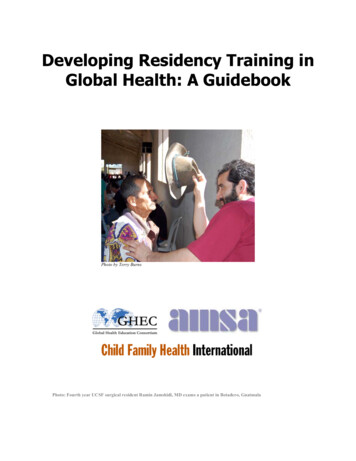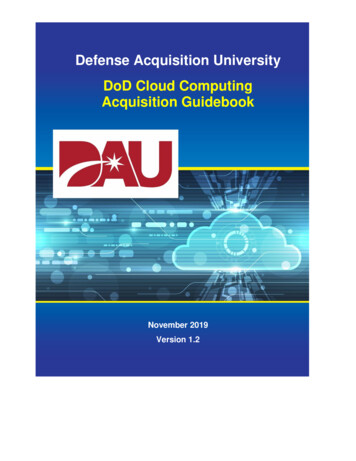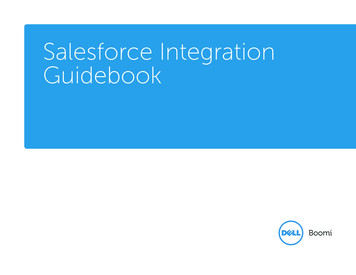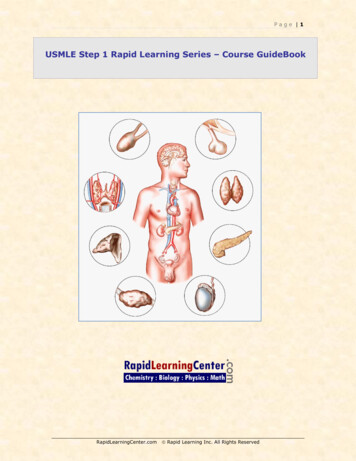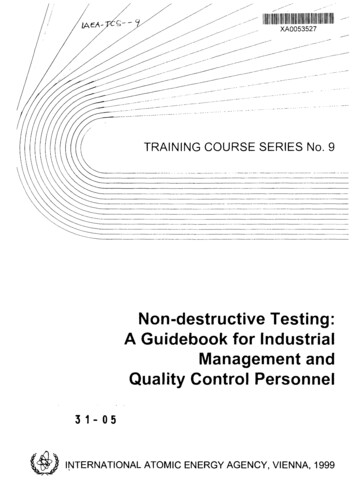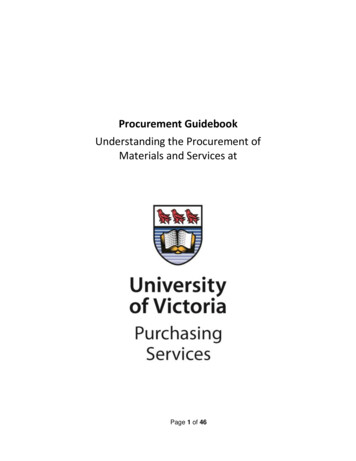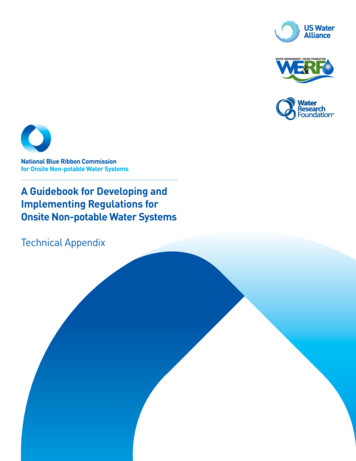
Transcription
A Guidebook for Developing andImplementing Regulations forOnsite Non-potable Water SystemsTechnical AppendixA Guidebook for Developing and Implementing RegulationsTechnical Appendix1
Contents3Appendix ATerminology7Appendix BExample Treatment Technologies, Treatment Trains,and Monitoring14Appendix CSample Engineering Report32Appendix DSample Reporting Documents42Appendix EBMPs for Storage and Distribution43Appendix FConsiderations for LegionellaA Guidebook for Developing and Implementing RegulationsTechnical Appendix2
Appendix A:Acronyms and TerminologyAcronymsTerminologyAWRCEAustralian Water Recycling Centre of ExcellenceBODBiological Oxygen DemandThe following terms are used throughout the document andhave the meaning set forth below.CResidual Disinfectant ConcentrationDDWState Water Resources Control Board’s Division ofDrinking WaterDVGWDeutsche Vereinigung des Gas und WasserfachesEPAEnvironmental Protection AgencyLRTLog Reduction TargetLT2ESWTRLong Term 2 Enhanced Surface Water TreatmentRuleMBRMembrane BioreactorMFMicrofiltrationNSFNational Science FoundationNTUNephelometric Turbidity UnitsNWRINational Water Research InstituteQMRAQuantitative Microbial Risk AssessmentONWSOnsite Non-potable Water SystemRMEResponsible Management EntityRPReduced Pressure Principle Backflow PreventionAssemblySWTRSurface Water Treatment RuleTContact TimeTDSTotal Dissolved SolidsTSSTotal Suspended SolidsUFUltrafiltrationUVUltraviolet lightUVTUltraviolet Light TransmittanceVOCVolatile Organic CompoundWE&RFWater Environment & Reuse FoundationWRFWater Research FoundationA Guidebook for Developing and Implementing RegulationsAir Gap: A physical break between a supply pipe and areceiving vessel as set forth in the local or state plumbingcode.Alternate Water Source: A source of non-potable waterthat may include any of the following—graywater, roof runoff,stormwater, blackwater, and any other source approved bythe state or local agency.Blackwater: Wastewater originating from toilets, urinals,and/or kitchen counters (i.e., kitchen sinks and dishwashers).Certified Laboratory: An environmental testing laboratorycertified by an accepted state accreditation program or theNational Environmental Laboratory Accreditation Program.Laboratories must be certified to perform each test forwhich they are providing results.Challenge Test: The evaluation of a unit treatment processfor pathogen log10 reduction performance using selectedsurrogate or indigenous constituents. In general, a surrogateis introduced to the process influent, and the processinfluent and effluent flow are monitored for the concentrationof the surrogate.Commercial Building: A building that is used for commercialpurposes.Continuous Verification Monitoring: Ongoing confirmationof system performance using sensors for continuousobservation of selected parameters, including surrogateparameters that are correlated with pathogen log reductiontarget requirements.Technical Appendix3
Cross-connection: When a plumbing system allows waterfrom one system (e.g., non-potable) to enter into anothersystem (e.g., potable), resulting in the contamination ofpotable water.Director: The Director of the state/local agency or anyindividual designated by the Director to act on his or herbehalf, including, but not limited to inspectors, and hasauthority to enforce the program rules.Disinfection: A physical or chemical process, including,but not limited to, ultraviolet radiation, ozonation, andchlorination that is used for removal, deactivation or killingof pathogenic microorganisms.District-Scale Project: An ONWS for a defined service areathat covers two or more properties and may cross publicrights-of-way.Domestic Wastewater: Wastewater collected from residen tial uses.Enforceable Legal Agreement: A legally enforceableagree ment defining the roles and responsibilities of eachproperty owner or entity acting as a permittee, supplier,or user of an ONWS.Field Verification: Performance confirmation study con duc ted using challenge testing, including surrogate micro organ isms and/or other non-biological surrogates, usuallyduring startup and commissioning and may be repeatedas needed. The need for, duration, and extent of the fieldverification procedure will depend on characteristics ofthe ONWS.First Flush Diverter: A device operated by mechanical floatvalves or other types of automatic control that diverts aquantity of roof runoff collected from a surface followingthe onset of a rain event.Graywater: Wastewater collected from non-blackwatersources, such as bathroom sinks, showers, bathtubs, clotheswashers, and laundry sinks.Incidental Runoff: Unintended small amounts (volume) ofrunoff from ONWS irrigation use areas, such as unintended,minimal over-spray that escapes the ONWS irrigationuse area. Water leaving an ONWS irrigation use area is notincidental if it is part of the facility design, if it is due toexcessive application, if it is due to intentional overflow orapplication, or if it is due to negligence.Indoor Use: Toilet and urinal flush water and clotheswashing.Local Agency: Any city, county, town, parish, or city andcounty with the jurisdictional authority to permit useof ONWS.Log10 Reduction: The removal of a pathogen or surrogatein a unit process expressed in log10 units. A 1-log reductionequates to 90% removal, 2-log reduction to 99% removal,3-log reduction to 99.9% removal, and so on.Log10 Reduction Credit: The log10 reduction value creditedto a treatment technology based on results of thetechnology’s validation test results and proposed surrogateparameter for continuous monitoring.Log10 Reduction Target: The log10 reduction target for thespecified pathogen group (i.e., viruses, bacteria, or protozoa)to achieve the identified level of risk to individuals (10-4infection per year).Mixed-Use Building: A building that contains residential andcommercial uses.Monitoring Report: A report documenting the operationand water quality results of an ONWS permitted under theprogram rules.Multi-Family Building: A residential building containingthree or more dwelling units.Multi-User Building: Any building that is not a singleresidence (e.g., multi-residential apartment, commercial,mixed use, and others).Municipal Wastewater: Wastewater collected on a municipalscale that may include industrial wastewater.A Guidebook for Developing and Implementing RegulationsTechnical Appendix4
Non-Potable Water: Non-potable water collected fromalternate water sources, treated, and intended to be usedon the project applicant’s site or district-scale projectand is suitable for direct beneficial use.Non-Residential Building: A building that contains occupan cies other than dwelling units.Onsite Non-Potable Water System (ONWS): A system inwhich water from local sources is collected, treated, andused for non-potable uses at the building to district/neighborhood-scale, generally at a location near the pointof generation.ONWS Engineering Report (Engineering Report): Reportsubmitted by project applicant to the local agency describingthe ONWS in accordance with the program rules adoptedby the local agency.Operations and Maintenance Manual: Document providingcomprehensive information on the ONWS operation,maintenance, and repair.Permit: Permit to operate an ONWS issued and enforcedby the local agency.Permittee: The person(s) who holds a valid permit grantedby the local agency to operate an ONWS. The Permittee isresponsible for maintaining a permit, assuring that watercollection, treatment, use, and water quality monitoring andreporting are consistent with the approved engineeringreport, the operations and maintenance manual, the programrules, and applicable state and local laws. A Permitteemay also be the supplier and/or user.Project Applicant: The person(s) or entity(s) applying forauthorization to install and use an ONWS. The projectapplicant is responsible for applying for the permit, assuringthat the ONWS is installed consistent with the approvedengineering report, the operations and maintenance manual,the program rules, and applicable state and local laws.Residential Building: A building that contains only dwellingunits.Roof Runoff: Precipitation from a rain or snowmelt eventthat is collected directly from a roof surface not subject tofrequent public access.A Guidebook for Developing and Implementing RegulationsSingle-Owner Occupied: A stand-alone building within itsown lot occupied by one group of residents.Site Supervisor: In a district-scale project, the qualifiedperson or entity designated by a user and/or supplier tooversee the operation and maintenance of the onsitedistribution system and/or collection system and act as aliaison to the treatment system manager and/or permittee.State Agency: The state agency with legal authority toadminister and/or provide oversight to local agencies seekingto implement programs that allow for ONWS.Stormwater: Precipitation runoff from rain or snowmeltevents that flows over land and/or impervious surfaces(e.g., streets and parking lots). Stormwater also includesrunoff from roofs with frequent public access.Supplier: An entity that supplies an untreated alternate watersource to the ONWS for treatment and reuse. A suppliermay also be a permittee and/or user.Surrogate Parameter: A measureable physical or chemicalproperty that has been demonstrated to provide a directcorrelation with the concentration of an indicator compound,can be used to monitor the efficiency of trace organiccompounds removals by a treatment process, and/or provideindication of a treatment process failure.Template for ONWS Engineering Reports: A fillable formidentifying and describing the required elements of theONWS engineering report.Template for ONWS Annual Reports: A fillable formidentifying and describing the required elements of theONWS annual report.Treatment System Manager: The qualified person orentity responsible for the daily management and oversightof the ONWS.Unrestricted Irrigation: Irrigation of ornamental plants(i.e., non-food) and dust suppression.User: An entity that accepts treated water from an ONWSfor beneficial purposes within its area of occupancy. A usermay also be a permittee and/or supplier.Technical Appendix5
Validation Report: Report documenting a detailed technologyevaluation study that was conducted to challenge thetreat ment technology over a wide range of operationalconditions. The validation report shall include evidence of thetreatment technology’s ability to reliably and consistentlyachieve the log reduction value, including information onthe required operating conditions and surrogate parametersthat require continuous monitoring.Water Balance: The calculation of the potential volume ofonsite alternate water supplies and demands of a develop ment project.Water Balance Documentation: An in-depth assessmentof the Project Applicant’s non-potable water use, includingsurvey information, water meter readings, water servicebilling information, ONWS schematic drawings, or any otherinformation deemed necessary by the local agency. Forproposed district-scale projects, water balance documen tation shall include implementation information that, at aminimum, shall address potential infrastructure and publicright of way conflicts, demonstrate compliance with allapplicable requirements, and establish the capabilities ofthe project applicant to effectively operate the districtscale system.A Guidebook for Developing and Implementing RegulationsTechnical Appendix6
Appendix B:Example Treatment Technologies,Treatment Trains, and MonitoringThis appendix includes example treatment technologies,treatment trains, and monitoring that could be usedto achieve the necessary LRTs. In order to meet the LRTsfor the range of alternate water sources and end uses,treat ment processes are designed in series to create aneffective treatment train. Treatment processes can achievepathogen removal and/or inactivation credits to meet theLRTs based on accepted pathogen crediting frameworks.The following treatment trains provide examples of howto meet the LRTs with common treatment technologiesincluding microfiltration (MF), ultrafiltration (UF), membranebiological reactor (MBR), ultraviolet light (UV) disinfection,and chlorination. Other treatment technologies such asozone disinfection and wetland treatment systems are notfeatured in these examples.The template treatment trains are adapted from TechnicalMemorandum on Pathogen Crediting Frameworks forDecentralized Non-potable Water Systems, TrussellTechnologies 2017. These treatment trains are not meantto be prescriptive, but to illustrate potential approachesfor the design of ONWS treatment trains using existingpathogen crediting frameworks.A Guidebook for Developing and Implementing RegulationsTechnical Appendix7
GraywaterAn example treatment train for ONWS treating graywaterfor indoor use is presented in Figure B-1. The treatmenttrain includes an MBR and UV, with the MBR meeting theAustralian guidelines for receiving pathogen credits. Inaddition, the MBR effluent quality (i.e. turbidity and UVT)must fall within the validated range for the UV reactor.The UV system provides a dose greater than or equal to150 mJ/cm2 under all validated operating conditions, asdemonstrated through online monitoring of several para meters. This treatment train exceeds the virus, protozoa,and bacteria LRTs.Figure B-1Example treatment train for ONWS treating graywater. Log reduction targets are based on a health risk assumption of10-4 infections per person per year.A Guidebook for Developing and Implementing RegulationsTechnical Appendix8
StormwaterAn example treatment train for ONWS treating stormwater(10-3 dilution) for indoor use is provided in Figure B-2,along with the validation, field verification, monitoring, andtreatment requirements. The treatment train includes MFand UV, with MF being credited according to the Californianon-potable reuse regulations and UV according to thedrinking water regulations. The use of MF instead of MBRin this train may be acceptable assuming that stormwaterhas significantly lower organic loads than graywater. Thisassumption would need to be confirmed in each case usingsite-specific water quality data.Figure B-2Example treatment train for ONWS treating stormwater (10-3 dilution of wastewater). Log reduction targets are basedon a health risk assumption of 10-4 infections per person per year.A Guidebook for Developing and Implementing RegulationsTechnical Appendix9
An example train for ONWS treating stormwater (10-1 dilution)for indoor use is provided in Figure B-3; the train consistsof MF, UV, and free chlorine. The MF is not credited withpathogen removal and/or inactivation, in accordance withCalifornia non-potable reuse requirements. In additionto meeting the non-potable effluent turbidity standards, theMF effluent must fall within the validated water qualityrange of the UV reactor. The UV reactor must provide a doseof at least 80 mJ/cm2. The chlorine system must provide aCT of no less than 10 mg-min/L, with a verified free chlorineresidual. A free chlorine dosing control system is requiredto ensure that free chlorine residual is maintained even inthe presence of ammonia in the feedwater. This treatmenttrain exceeds the virus, protozoa, and bacteria LRTs. Aswith the 10-3 stormwater treatment train, the water qualityof the source water should be evaluated to verify thatsufficient organics control can be obtained without the useof MBR, i.e., with MF alone.Figure B-3Example treatment train for ONWS treating stormwater (10-1 dilution of wastewater). Log reduction targets are basedon a health risk assumption of 10-4 infections per person per year.A Guidebook for Developing and Implementing RegulationsTechnical Appendix10
Roof RunoffThe Sharvelle et al., 2017 report specifies only bacterialLRTs for roof runoff; there are no LRTs for virus or protozoa.The example treatment train in Figure B-4, showing ONWStreating roof runoff for indoor use, uses UV with a dose of80 mJ/cm2 to achieve the bacterial LRTs. This treatmenttrain may need to be preceded by a filtration step to removesolids; this determination should be made based on thequality of a particular source water.Figure B-4Example treatment train for ONWS treating roof runoff. Log reduction targets are based on a health risk assumption of10-4 infections per person per year.A Guidebook for Developing and Implementing RegulationsTechnical Appendix11
BlackwaterTwo example treatment trains for ONWS treating blackwaterfor indoor use are shown in Figure B-5 and B-6. The keydifference between these trains is whether or not the MBRreceives pathogen credit. Figure A-5 includes an MBR, MF,UV, and free chlorine. In this train, the only requirement forthe MBR is that it meets the California non-potable effluentturbidity standards. The MF can receive protozoa credit witha daily pressure decay test and effluent turbidity meetingthe drinking water standards. In addition, the MF effluentquality must be within the validated range of the UV reactor.The MBR is not replaced by the MF because the biologicaltreatment is necessary to reduce the concen tration oforganics. The MF is included to obtain the additional neces sary protozoa credit. The chlorine system must provide aCT of no less than 10 mg-min/L, with a verified free chlorineresidual. A free chlorine dosing control system is requiredto ensure that free chlorine residual is maintained even inthe presence of ammonia in the feedwater.Figure B-5Example treatment train A for ONWS treating blackwater. Log reduction targets are based on a health risk assumptionof 10-4 infections per person per year.A Guidebook for Developing and Implementing RegulationsTechnical Appendix12
Figure B-6 consists of an MBR, UV, and free chlorine. In thistrain, the MBR receives pathogen credit per the Australianguidelines. The MBR must operate within the Tier 1 operatingenvelope, with an effluent turbidity 0.2 NTU. The MBReffluent must be within the validated range of water qualityof the UV reactor. The UV reactor (or multiple reactors inseries) must provide a UV dose of 80 mJ/cm2 to receive3.5-log virus and bacteria credit and 6-log protozoa credit.The remaining virus credits are obtained through freechlorine disinfection per the same requirements noted inexample treatment train A for ONWS treating blackwater.Figure B-6Example treatment train B for ONWS treating blackwater. Log reduction targets are based on a health risk assumptionof 10-4 infections per person per year.A Guidebook for Developing and Implementing RegulationsTechnical Appendix13
Appendix C:Sample Engineering ReportThis template is intended to aid Permit Applicants in writingan ONWS Engineering Report. ONWS vary in complexity;therefore, reports will vary in content, and the detailpresented will depend on the scope of the proposed project.The report should contain sufficient information to assurethe local agency that the degree and reliability of treatmentis commensurate with the requirements for the proposeduse and that the distribution and use of the treated nonpotable water will be protective of public health.The local agency should approve the engineering reportas the permitting agency for the operation of ONWS inResidential Buildings containing three or more dwellingunits, in non-Residential Buildings, and where ONWSare shared across property lines or in multiple structures.A Guidebook for Developing and Implementing RegulationsTechnical Appendix14
Onsite Non-potable Water System Engineering Report[Insert Responsible Party][Insert Project Name][Insert Project Address]Prepared by:[Insert Engineer Name][Insert Company Name][Insert Company Address][Insert Registered Professional Engineer Seal and Signature]Submitted to: Local agencyDate: [Insert Date]1A Guidebook for Developing and Implementing RegulationsTechnical Appendix15
Table of Contents1.2.3.4.5.6.7.8.9.10.GeneralRegulatory
A Guidebook for Developing and Implementing Regulations Technical Appendix 4 Cross-connection: When a plumbing system allows water from one system (e.g., non-potable) to enter into another system (e.g., potable), resulting in the contamination of
